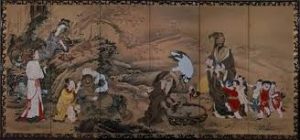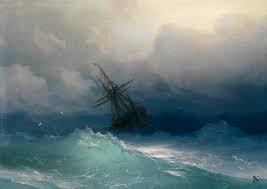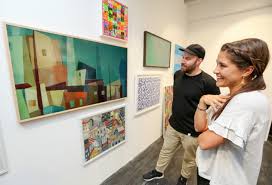VLADIMIR SCHOOL SCHOOL SCHOOL (part 2)
 By the 1970s, the recognizable style of painting, common to all representatives of the Vladimir school, was finally formed. The landscape space in them, as a rule, is reduced to a plane. The plans are brought together, the composition is extremely simple, the horizon line in the paintings is deliberately overestimated. This set of techniques gives reason to talk about the closeness of their aesthetics with the stylistic principles of Rostov-Suzdal icon painting … The letter in Vladimir painting is temperamental, the texture is particularly striking. A completely unique find of Vladimirites is the use of experimental bulk soils that enhance the decorative effect of textured writing. Bright, pasty painting on the textured soil, different heights of the colorful relief in the picture increased the living trepidation of the depicted, enhanced the contrast of the color scheme.
By the 1970s, the recognizable style of painting, common to all representatives of the Vladimir school, was finally formed. The landscape space in them, as a rule, is reduced to a plane. The plans are brought together, the composition is extremely simple, the horizon line in the paintings is deliberately overestimated. This set of techniques gives reason to talk about the closeness of their aesthetics with the stylistic principles of Rostov-Suzdal icon painting … The letter in Vladimir painting is temperamental, the texture is particularly striking. A completely unique find of Vladimirites is the use of experimental bulk soils that enhance the decorative effect of textured writing. Bright, pasty painting on the textured soil, different heights of the colorful relief in the picture increased the living trepidation of the depicted, enhanced the contrast of the color scheme.
The long-term fruitful development of the Vladimir school of painting contributed to the emergence of such talented and original masters as S. Bakhvalov, A. Kuvin, V. Kuvin, N. Kournikov, E. Redko, V. Sevostyanov, V. Fedyanov, A. Kharchenko, helped to reveal the talents young painters – V. Fomyuk and D. Kholin. A. Kuvin’s work amazes with both a large selection of themes and a wide range of artistic techniques. So the canvas “It’s time to hay”, made in the 70s of the last century in a realistic manner, conveys the joy of the unity of people in joint work. The painting “Spring” immerses the viewer in a world of silence. “Street in the village” and “Spring evening” turn the viewer to an impressionistic vision of the world. From the picture “Under the Sail” it breathes serenity and happiness. Close to her mood is the work “On the River” decided in the same color scheme.
Yu. Matushevsky was represented at the exhibition by paintings of the sixties of the 20th century, traditional for the Vladimir school of painting: “Cathedral”, “On the Trubezh River”, in which the architectural motif becomes a symbol of nationality. The works of N. Kournikov of the sixties and eighties of the twentieth century are represented by the monumental painting “View of the Intercession Monastery” and peculiar landscapes-moods “Kovrovsky Motive” and “Windy Day”.
Aesthetics of color – this is the main thing that sets Vladimir artists apart from landscape painters from other schools. It is color that is the leading expressive means in the winter landscape of G. Kachalov “Sunday Morning”, in his own painting with the saying title “Lilac Sun”, in the works of S. Bakhvalov “Blue Snow”, V. Khamkov “Winter Landscape” and V. Bobrov “The Last Ray”, allowing you to create a major, optimistic mood.
Although the continuity of traditions has always remained a characteristic feature of the Vladimir school of landscape, there has always been a place for searching. The manner of E. Telegin eloquently speaks about this. The painter proved himself to be a subtle lyricist: using muted, exquisite silver-pearl tones, he showed new ones, he created the image of the nature of the Vladimir land – elegantly enlightened, refined – in the works “May Rains” and “May Time”.
V. Bataev in his paintings “Spring in Vladimir”, “Autumn in Vladimir”, “Breath of Spring” is the continuation of the realistic traditions of the second half of the XIX century. Involuntarily, the Moscow Yard by V. Polenov comes to mind, the Rooks Have Arrived by V. Savrasov.
In the works of the young artist D. Kholin sound Kustodievsky motifs. Such are his bright works “Palm Sunday”, “Temples of the Great Ustyug” with the azure shining of the sky and burning gold of crosses on the domes of temples. The arrogance and fun of Russian fairs and festivals are present in his canvases “Palm Sunday”, “A Game of Three Hundreds”, which are distinguished by deliberate primitivism and low-key naivety of the composition. A completely different talent of D.Kholin opens in the southern landscapes of Sochi. Southern Pearl. ” “On the top. Krasnaya Polyana in Sochi ”,“ Abkhazia. Ritsa Lake ”written in a wide, juicy brushstroke. These paintings seem to emit streams of color energy.
In recent years, Vladimir artists have expanded the genre range, more and more carried away by still life. Among these works is a major still life of the young master V. Fomyuk “Summer Table” – a picture that conveys a feeling of summer abundance and happiness of life, pouring over the edge of a full bowl.
The variety of individual manners of Vladimir artists, the genre breadth inherent in them in recent years, erodes the existing channel of the single style in which the founders of the Vladimir school of landscape continue to work today. But in these changes, perhaps, the good prerequisites of further artistic searches, new ways of development are laid. Today, the best works of painters of the Vladimir school, its leading masters, are stored in the central art collections of Russia – the Tretyakov Gallery and the Russian Museum, as well as in a number of other domestic and foreign museums and private collections.




